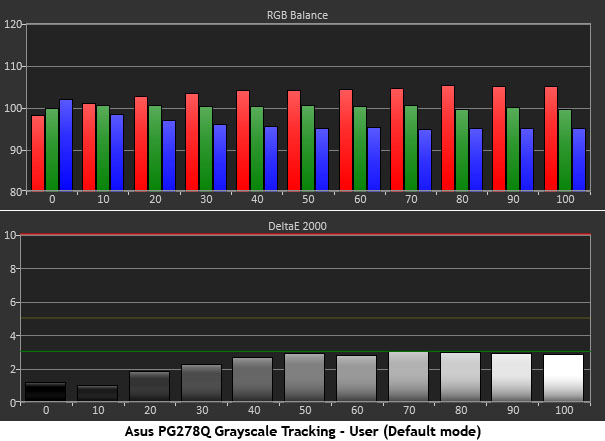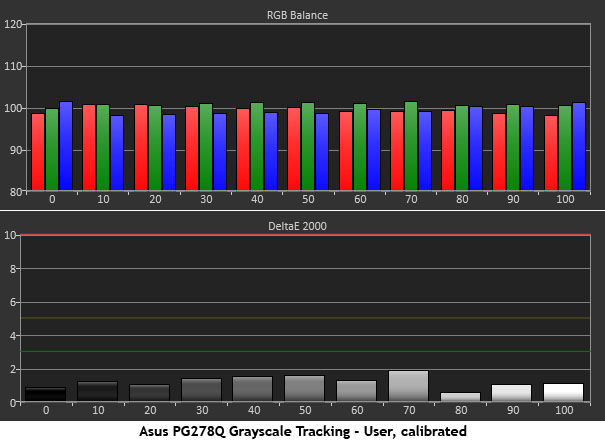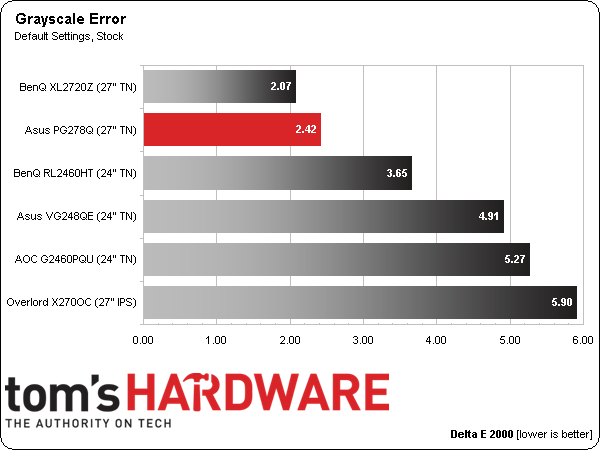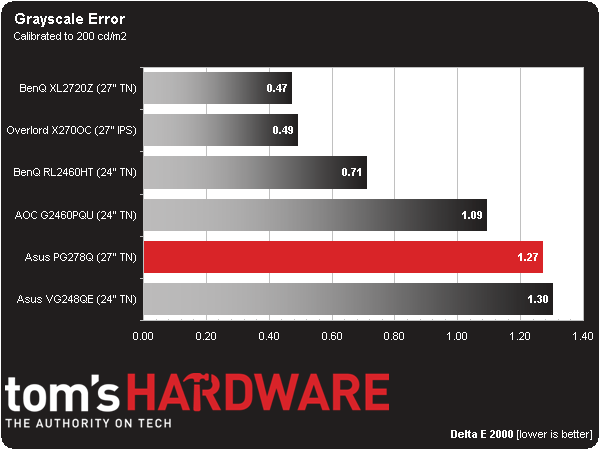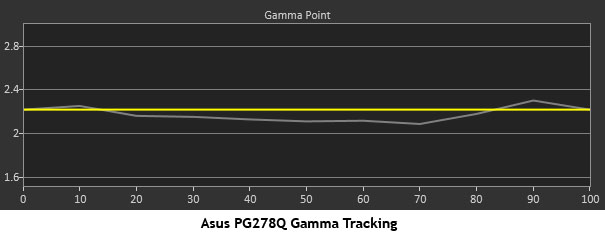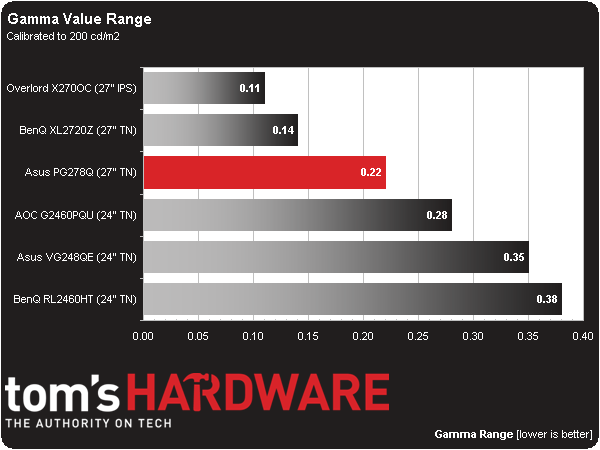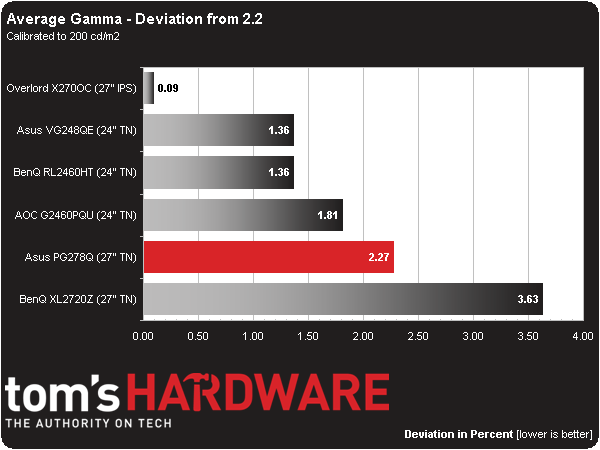Asus ROG Swift PG278Q 27-inch G-Sync Monitor Review
We’ve been waiting to experience the wonders of G-Sync for months, and Asus is the first company to deliver a finished product. Its ROG Swift PG278Q is a 27-inch QHD TN-based display with G-Sync, 144 Hz operation, and ULMB, a new blur-reduction feature.
Results: Grayscale Tracking and Gamma Response
The majority of monitors, especially newer models, display excellent grayscale tracking (even at stock settings). It’s important that the color of white be consistently neutral at all light levels from darkest to brightest. Grayscale performance impacts color accuracy with regard to the secondary colors: cyan, magenta, and yellow. Since computer monitors typically have no color or tint adjustment, accurate grayscale is key.
User is the default color temp mode and it’s pretty close to correct. The RGB Balance chart shows a tendency towards red, but all of the errors are under three Delta E and therefore very hard to see. Even still, we observed an improvement after calibration.
Adjusting the RGB controls gives us a better result that is now under two Delta E across the board. You give up a tiny bit of contrast, but we think it’s worth it.
Here is our comparison group:
A Delta E measurement of 2.42 puts the PG278Q near the top in out-of-box grayscale performance. In fact, its result exceeds a few professional-class monitors we’ve tested. We feel most gamers would be satisfied with the Swift in its uncalibrated state.
A little adjustment brings the average error down to 1.27 Delta E. The improvement in image quality is noticeable to our eyes. When you always use a calibrated monitor, a display with even a tiny error doesn't look quite right. Today though, the grayscale prize goes to BenQ's XL2720Z with its stellar numbers.
Gamma Response
Gamma is the measurement of luminance levels at every step in the brightness range from 0 to 100 percent. This is important because poor gamma can either crush detail at various points or wash it out, making the entire picture appear flat and dull. Correct gamma produces a more three-dimensional image, with a greater sense of depth and realism. Meanwhile, incorrect gamma can negatively affect image quality, even in monitors with high contrast ratios.
Get Tom's Hardware's best news and in-depth reviews, straight to your inbox.
In the gamma charts below, the yellow line represents 2.2, which is the most widely used standard for television, film, and computer graphics production. The closer the white measurement trace comes to 2.2, the better.
The gamma tracking runs just a tiny bit light at an average value of 2.15. It’s only slightly off of our standard and again, most users won’t notice. We do wish there was a gamma adjustment, however. Some games benefit from a little lighter or darker tone to help bring out detail. Fortunately, many developers add a software-based slider to compensate.
Here is our comparison group again:
The difference between the highest (2.29) and lowest (2.07) values is pretty small, indicating good tracking. There aren’t any significant dips or peaks to spoil the result.
We calculate gamma deviation by simply expressing the difference from 2.2 as a percentage.
A 2.15 average puts the PG278Q in fifth place among today’s group. Overall, we’re perfectly satisfied with its gamma performance. Our only beef is the lack of additional presets.
Current page: Results: Grayscale Tracking and Gamma Response
Prev Page Results: Brightness and Contrast Next Page Results: Color Gamut and Performance
Christian Eberle is a Contributing Editor for Tom's Hardware US. He's a veteran reviewer of A/V equipment, specializing in monitors. Christian began his obsession with tech when he built his first PC in 1991, a 286 running DOS 3.0 at a blazing 12MHz. In 2006, he undertook training from the Imaging Science Foundation in video calibration and testing and thus started a passion for precise imaging that persists to this day. He is also a professional musician with a degree from the New England Conservatory as a classical bassoonist which he used to good effect as a performer with the West Point Army Band from 1987 to 2013. He enjoys watching movies and listening to high-end audio in his custom-built home theater and can be seen riding trails near his home on a race-ready ICE VTX recumbent trike. Christian enjoys the endless summer in Florida where he lives with his wife and Chihuahua and plays with orchestras around the state.
-
TechyInAZ Nice! This is great since I am one of those picky guys that believes that 30fps doesn't bring a good enough gaming experience.Reply
But one thing I do hope for is a 144hz g-sync IPS monitor, ever since I've gotten my new Asus MX239H the ips makes a huge difference in games.
But besides that, it is a glorious monitor, resolution is great, 144hz, and of course g sync makes it a wonderful monitor.
But really $800? I know that it is one of the few g sync equipped monitors, but you can buy a 4k monitor for $650! -
CraigN Yes - please fix that Amazon link. I almost shat myself thinking that was available already.Reply
-
apertotes Anybody knows if the incompatibility between G-Sync and ULMB is something that will get fixed or is here to stay?Reply -
CraigN Reply13933468 said:Anybody knows if the incompatibility between G-Sync and ULMB is something that will get fixed or is here to stay?
Pretty unlikely. ULMB requires a static refresh rate, because it has to strobe the monitor at a constant rate. GSYNC would mean that it would have to strobe in time with each frame, at a variable rate. You would introduce a lag time on the strobing if you tried to do this, since it would be at a variable rate instead of a constant one. -
rh_dog I know it's expensive for 2560x1440, I know it's not IPS, but to get the refresh rate @144hz and the 1ms g2g and g-sync? The few reviews for this monitor that are out there are all glowing. Come on, Asus, release the thing already, I've been waiting since the Jan announcement for this monitor. Shut up and take my money!!!Reply -
Rendezvous Omg! I need this now..... I alrdy have 800 set aside for it...I need a exact release date now!Reply -
agentbb007 Asus has said on Twitter it should be in the US by the end of August. I can't wait for this, I'm checking newegg everyday to see when it shows up! I hope they have enough of these coming in because there seems to be a lot of people waiting to buy this monitor.Reply
